Avoiding Language Barriers: Cultural Awareness in Nursing Practice
VerifiedAdded on 2023/01/17
|13
|2792
|47
Report
AI Summary
This report delves into the crucial topic of cultural awareness and language barriers within nursing practice. It explores the impact of language barriers on effective communication between nurses and patients from diverse backgrounds, highlighting the significance of cultural sensitivity. The report outlines research objectives, including increasing cultural awareness among nursing staff to minimize communication challenges. It examines relevant and irrelevant information, organizes findings from literature reviews and articles, and contrasts key studies on language barriers in healthcare. The report also discusses the impact of cultural awareness on patient care, the use of gathered information, and offers reflections on the importance of overcoming language barriers. The conclusion emphasizes the need for staff to develop strategies for communicating with diverse clients, ultimately enhancing the quality of care provided. This report is a valuable resource for understanding and addressing language barriers in healthcare settings.
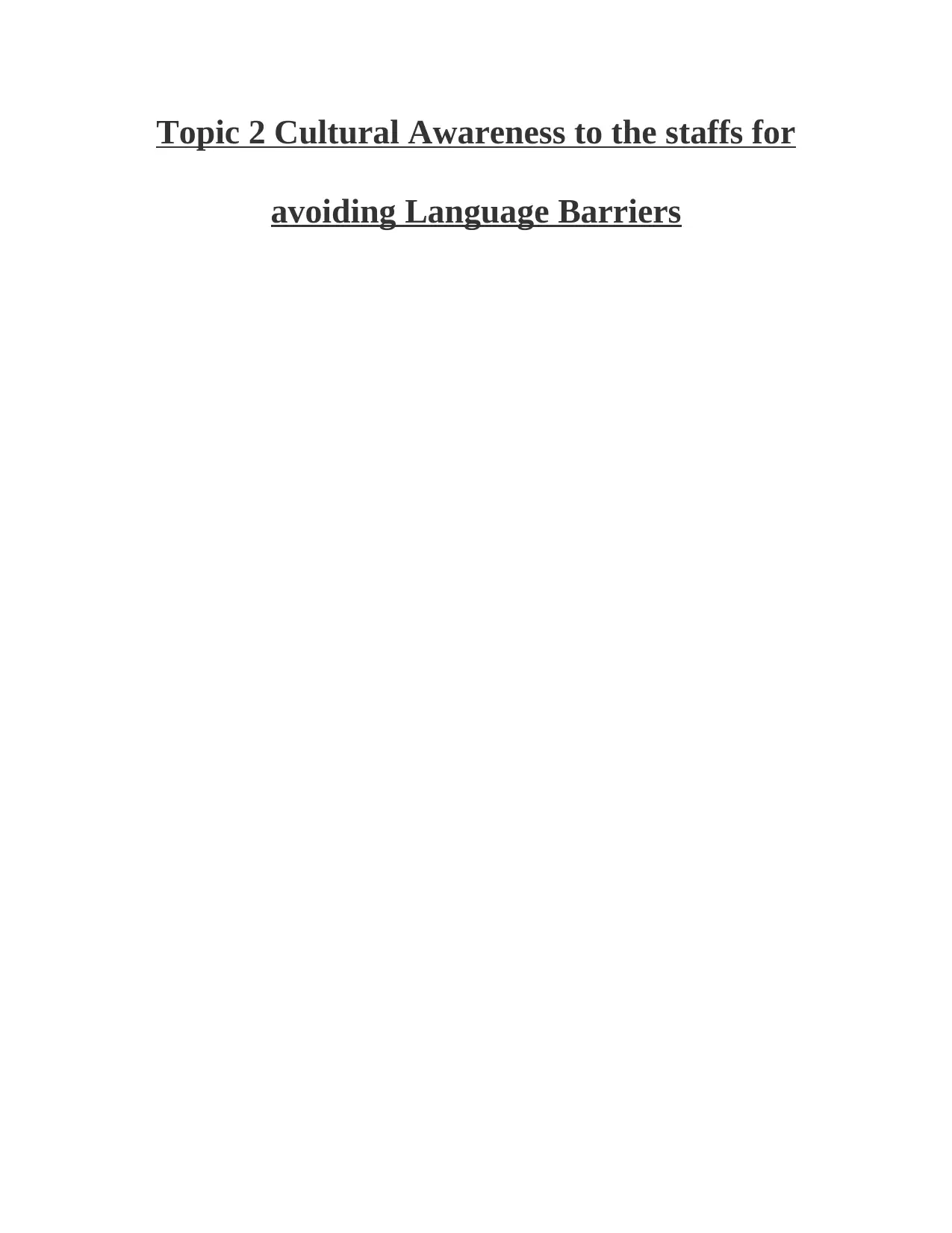
Topic 2 Cultural Awareness to the staffs for
avoiding Language Barriers
avoiding Language Barriers
Paraphrase This Document
Need a fresh take? Get an instant paraphrase of this document with our AI Paraphraser
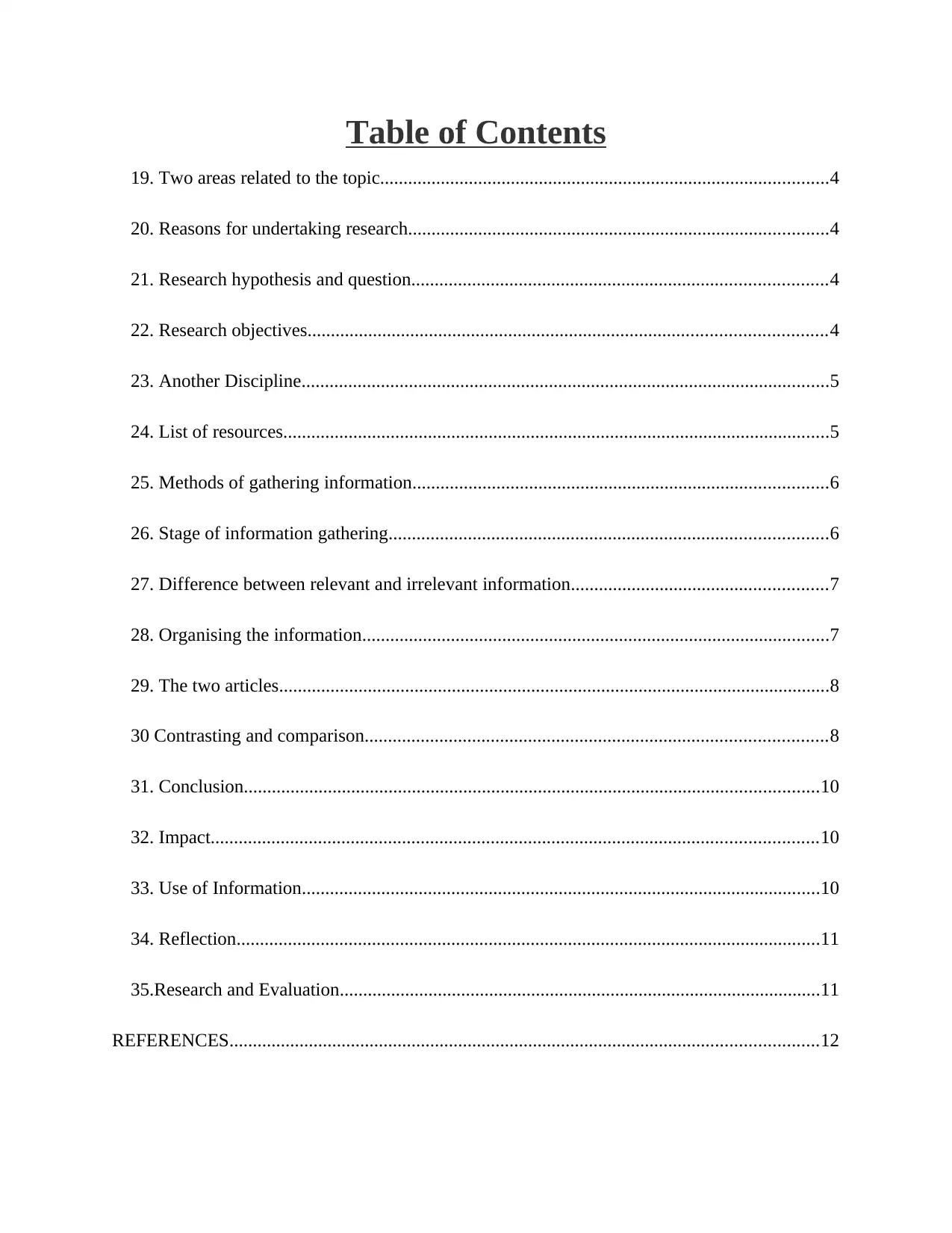
Table of Contents
19. Two areas related to the topic................................................................................................4
20. Reasons for undertaking research..........................................................................................4
21. Research hypothesis and question.........................................................................................4
22. Research objectives...............................................................................................................4
23. Another Discipline.................................................................................................................5
24. List of resources.....................................................................................................................5
25. Methods of gathering information.........................................................................................6
26. Stage of information gathering..............................................................................................6
27. Difference between relevant and irrelevant information.......................................................7
28. Organising the information....................................................................................................7
29. The two articles......................................................................................................................8
30 Contrasting and comparison...................................................................................................8
31. Conclusion...........................................................................................................................10
32. Impact..................................................................................................................................10
33. Use of Information...............................................................................................................10
34. Reflection.............................................................................................................................11
35.Research and Evaluation.......................................................................................................11
REFERENCES..............................................................................................................................12
19. Two areas related to the topic................................................................................................4
20. Reasons for undertaking research..........................................................................................4
21. Research hypothesis and question.........................................................................................4
22. Research objectives...............................................................................................................4
23. Another Discipline.................................................................................................................5
24. List of resources.....................................................................................................................5
25. Methods of gathering information.........................................................................................6
26. Stage of information gathering..............................................................................................6
27. Difference between relevant and irrelevant information.......................................................7
28. Organising the information....................................................................................................7
29. The two articles......................................................................................................................8
30 Contrasting and comparison...................................................................................................8
31. Conclusion...........................................................................................................................10
32. Impact..................................................................................................................................10
33. Use of Information...............................................................................................................10
34. Reflection.............................................................................................................................11
35.Research and Evaluation.......................................................................................................11
REFERENCES..............................................................................................................................12

⊘ This is a preview!⊘
Do you want full access?
Subscribe today to unlock all pages.

Trusted by 1+ million students worldwide
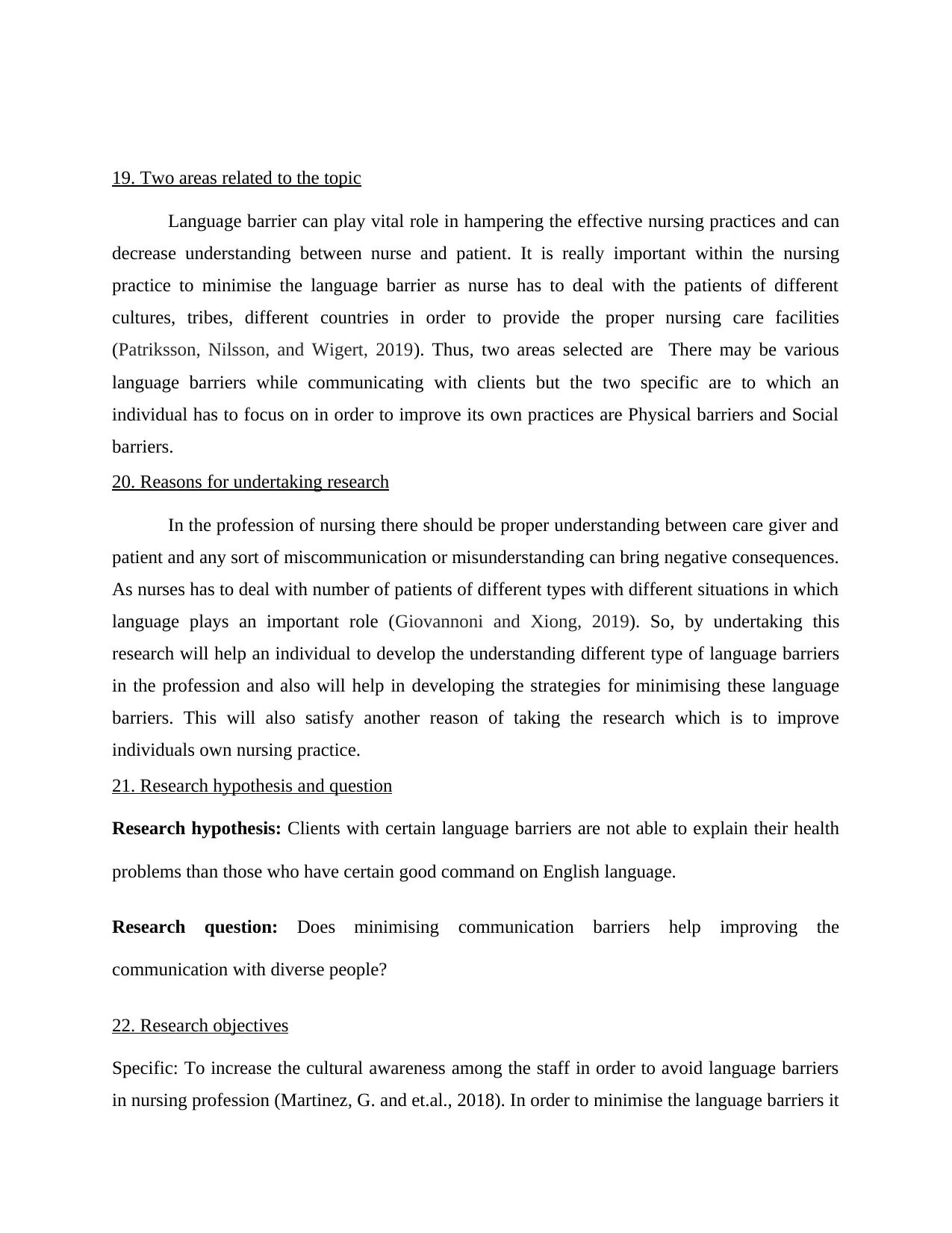
19. Two areas related to the topic
Language barrier can play vital role in hampering the effective nursing practices and can
decrease understanding between nurse and patient. It is really important within the nursing
practice to minimise the language barrier as nurse has to deal with the patients of different
cultures, tribes, different countries in order to provide the proper nursing care facilities
(Patriksson, Nilsson, and Wigert, 2019). Thus, two areas selected are There may be various
language barriers while communicating with clients but the two specific are to which an
individual has to focus on in order to improve its own practices are Physical barriers and Social
barriers.
20. Reasons for undertaking research
In the profession of nursing there should be proper understanding between care giver and
patient and any sort of miscommunication or misunderstanding can bring negative consequences.
As nurses has to deal with number of patients of different types with different situations in which
language plays an important role (Giovannoni and Xiong, 2019). So, by undertaking this
research will help an individual to develop the understanding different type of language barriers
in the profession and also will help in developing the strategies for minimising these language
barriers. This will also satisfy another reason of taking the research which is to improve
individuals own nursing practice.
21. Research hypothesis and question
Research hypothesis: Clients with certain language barriers are not able to explain their health
problems than those who have certain good command on English language.
Research question: Does minimising communication barriers help improving the
communication with diverse people?
22. Research objectives
Specific: To increase the cultural awareness among the staff in order to avoid language barriers
in nursing profession (Martinez, G. and et.al., 2018). In order to minimise the language barriers it
Language barrier can play vital role in hampering the effective nursing practices and can
decrease understanding between nurse and patient. It is really important within the nursing
practice to minimise the language barrier as nurse has to deal with the patients of different
cultures, tribes, different countries in order to provide the proper nursing care facilities
(Patriksson, Nilsson, and Wigert, 2019). Thus, two areas selected are There may be various
language barriers while communicating with clients but the two specific are to which an
individual has to focus on in order to improve its own practices are Physical barriers and Social
barriers.
20. Reasons for undertaking research
In the profession of nursing there should be proper understanding between care giver and
patient and any sort of miscommunication or misunderstanding can bring negative consequences.
As nurses has to deal with number of patients of different types with different situations in which
language plays an important role (Giovannoni and Xiong, 2019). So, by undertaking this
research will help an individual to develop the understanding different type of language barriers
in the profession and also will help in developing the strategies for minimising these language
barriers. This will also satisfy another reason of taking the research which is to improve
individuals own nursing practice.
21. Research hypothesis and question
Research hypothesis: Clients with certain language barriers are not able to explain their health
problems than those who have certain good command on English language.
Research question: Does minimising communication barriers help improving the
communication with diverse people?
22. Research objectives
Specific: To increase the cultural awareness among the staff in order to avoid language barriers
in nursing profession (Martinez, G. and et.al., 2018). In order to minimise the language barriers it
Paraphrase This Document
Need a fresh take? Get an instant paraphrase of this document with our AI Paraphraser
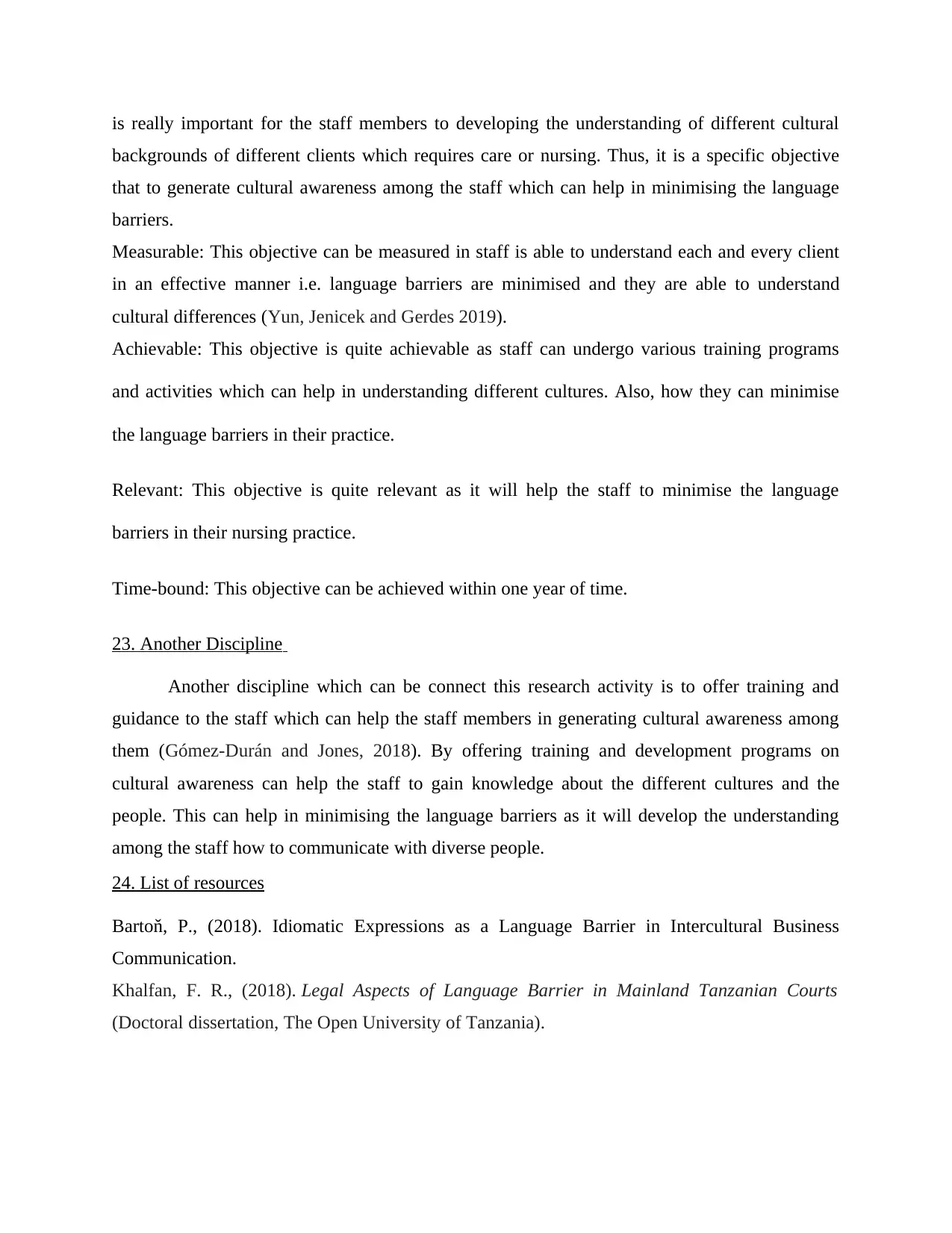
is really important for the staff members to developing the understanding of different cultural
backgrounds of different clients which requires care or nursing. Thus, it is a specific objective
that to generate cultural awareness among the staff which can help in minimising the language
barriers.
Measurable: This objective can be measured in staff is able to understand each and every client
in an effective manner i.e. language barriers are minimised and they are able to understand
cultural differences (Yun, Jenicek and Gerdes 2019).
Achievable: This objective is quite achievable as staff can undergo various training programs
and activities which can help in understanding different cultures. Also, how they can minimise
the language barriers in their practice.
Relevant: This objective is quite relevant as it will help the staff to minimise the language
barriers in their nursing practice.
Time-bound: This objective can be achieved within one year of time.
23. Another Discipline
Another discipline which can be connect this research activity is to offer training and
guidance to the staff which can help the staff members in generating cultural awareness among
them (Gómez-Durán and Jones, 2018). By offering training and development programs on
cultural awareness can help the staff to gain knowledge about the different cultures and the
people. This can help in minimising the language barriers as it will develop the understanding
among the staff how to communicate with diverse people.
24. List of resources
Bartoň, P., (2018). Idiomatic Expressions as a Language Barrier in Intercultural Business
Communication.
Khalfan, F. R., (2018). Legal Aspects of Language Barrier in Mainland Tanzanian Courts
(Doctoral dissertation, The Open University of Tanzania).
backgrounds of different clients which requires care or nursing. Thus, it is a specific objective
that to generate cultural awareness among the staff which can help in minimising the language
barriers.
Measurable: This objective can be measured in staff is able to understand each and every client
in an effective manner i.e. language barriers are minimised and they are able to understand
cultural differences (Yun, Jenicek and Gerdes 2019).
Achievable: This objective is quite achievable as staff can undergo various training programs
and activities which can help in understanding different cultures. Also, how they can minimise
the language barriers in their practice.
Relevant: This objective is quite relevant as it will help the staff to minimise the language
barriers in their nursing practice.
Time-bound: This objective can be achieved within one year of time.
23. Another Discipline
Another discipline which can be connect this research activity is to offer training and
guidance to the staff which can help the staff members in generating cultural awareness among
them (Gómez-Durán and Jones, 2018). By offering training and development programs on
cultural awareness can help the staff to gain knowledge about the different cultures and the
people. This can help in minimising the language barriers as it will develop the understanding
among the staff how to communicate with diverse people.
24. List of resources
Bartoň, P., (2018). Idiomatic Expressions as a Language Barrier in Intercultural Business
Communication.
Khalfan, F. R., (2018). Legal Aspects of Language Barrier in Mainland Tanzanian Courts
(Doctoral dissertation, The Open University of Tanzania).
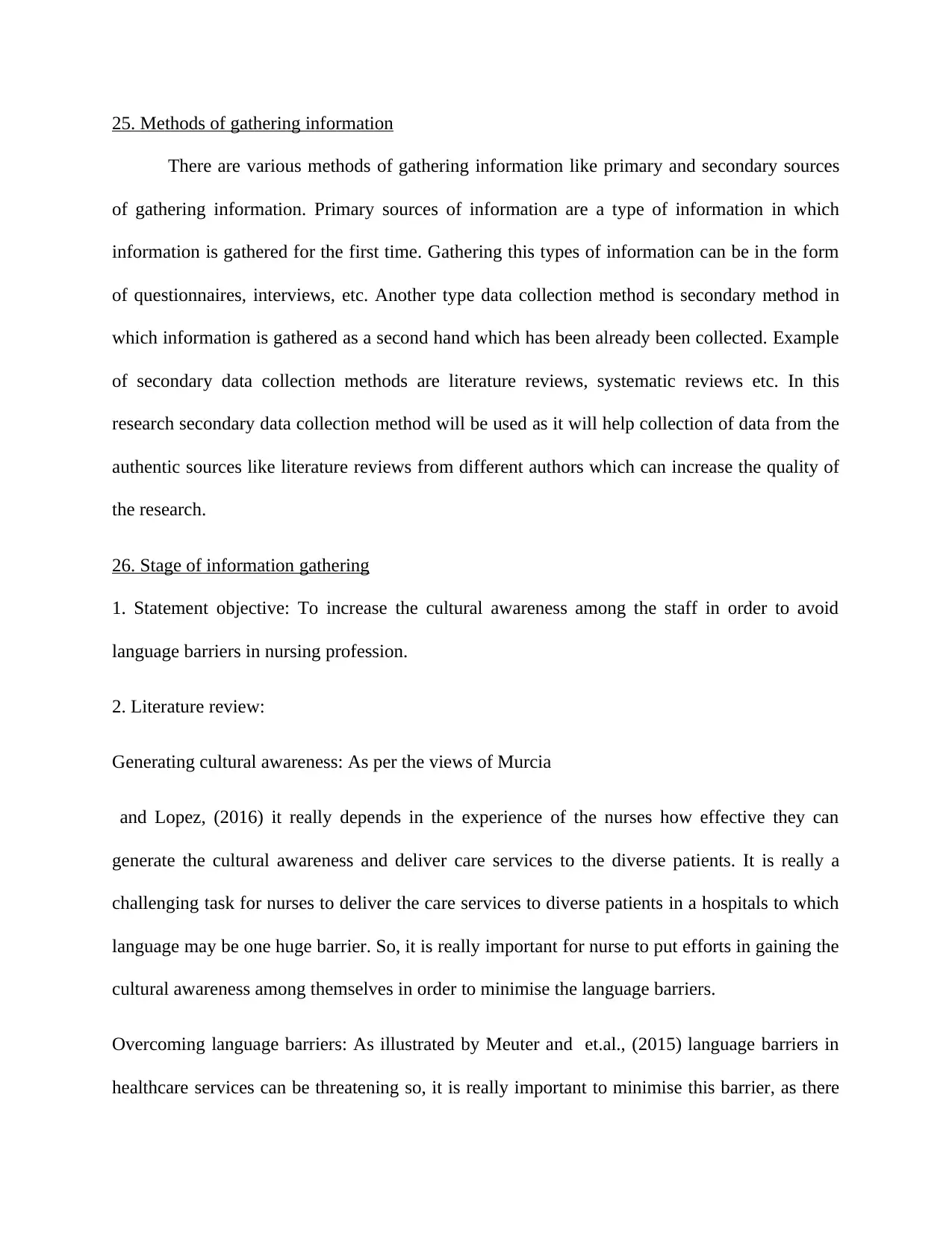
25. Methods of gathering information
There are various methods of gathering information like primary and secondary sources
of gathering information. Primary sources of information are a type of information in which
information is gathered for the first time. Gathering this types of information can be in the form
of questionnaires, interviews, etc. Another type data collection method is secondary method in
which information is gathered as a second hand which has been already been collected. Example
of secondary data collection methods are literature reviews, systematic reviews etc. In this
research secondary data collection method will be used as it will help collection of data from the
authentic sources like literature reviews from different authors which can increase the quality of
the research.
26. Stage of information gathering
1. Statement objective: To increase the cultural awareness among the staff in order to avoid
language barriers in nursing profession.
2. Literature review:
Generating cultural awareness: As per the views of Murcia
and Lopez, (2016) it really depends in the experience of the nurses how effective they can
generate the cultural awareness and deliver care services to the diverse patients. It is really a
challenging task for nurses to deliver the care services to diverse patients in a hospitals to which
language may be one huge barrier. So, it is really important for nurse to put efforts in gaining the
cultural awareness among themselves in order to minimise the language barriers.
Overcoming language barriers: As illustrated by Meuter and et.al., (2015) language barriers in
healthcare services can be threatening so, it is really important to minimise this barrier, as there
There are various methods of gathering information like primary and secondary sources
of gathering information. Primary sources of information are a type of information in which
information is gathered for the first time. Gathering this types of information can be in the form
of questionnaires, interviews, etc. Another type data collection method is secondary method in
which information is gathered as a second hand which has been already been collected. Example
of secondary data collection methods are literature reviews, systematic reviews etc. In this
research secondary data collection method will be used as it will help collection of data from the
authentic sources like literature reviews from different authors which can increase the quality of
the research.
26. Stage of information gathering
1. Statement objective: To increase the cultural awareness among the staff in order to avoid
language barriers in nursing profession.
2. Literature review:
Generating cultural awareness: As per the views of Murcia
and Lopez, (2016) it really depends in the experience of the nurses how effective they can
generate the cultural awareness and deliver care services to the diverse patients. It is really a
challenging task for nurses to deliver the care services to diverse patients in a hospitals to which
language may be one huge barrier. So, it is really important for nurse to put efforts in gaining the
cultural awareness among themselves in order to minimise the language barriers.
Overcoming language barriers: As illustrated by Meuter and et.al., (2015) language barriers in
healthcare services can be threatening so, it is really important to minimise this barrier, as there
⊘ This is a preview!⊘
Do you want full access?
Subscribe today to unlock all pages.

Trusted by 1+ million students worldwide
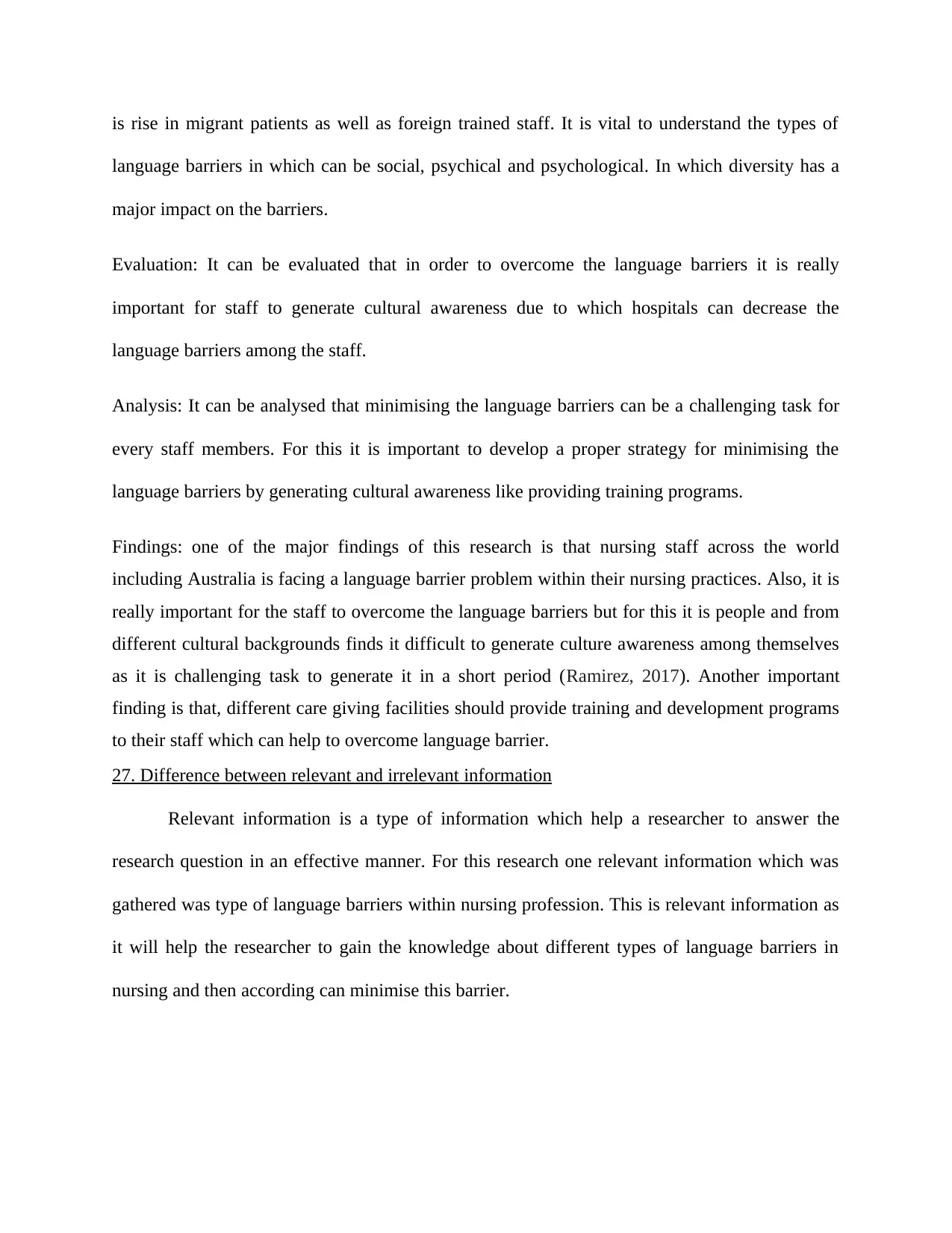
is rise in migrant patients as well as foreign trained staff. It is vital to understand the types of
language barriers in which can be social, psychical and psychological. In which diversity has a
major impact on the barriers.
Evaluation: It can be evaluated that in order to overcome the language barriers it is really
important for staff to generate cultural awareness due to which hospitals can decrease the
language barriers among the staff.
Analysis: It can be analysed that minimising the language barriers can be a challenging task for
every staff members. For this it is important to develop a proper strategy for minimising the
language barriers by generating cultural awareness like providing training programs.
Findings: one of the major findings of this research is that nursing staff across the world
including Australia is facing a language barrier problem within their nursing practices. Also, it is
really important for the staff to overcome the language barriers but for this it is people and from
different cultural backgrounds finds it difficult to generate culture awareness among themselves
as it is challenging task to generate it in a short period (Ramirez, 2017). Another important
finding is that, different care giving facilities should provide training and development programs
to their staff which can help to overcome language barrier.
27. Difference between relevant and irrelevant information
Relevant information is a type of information which help a researcher to answer the
research question in an effective manner. For this research one relevant information which was
gathered was type of language barriers within nursing profession. This is relevant information as
it will help the researcher to gain the knowledge about different types of language barriers in
nursing and then according can minimise this barrier.
language barriers in which can be social, psychical and psychological. In which diversity has a
major impact on the barriers.
Evaluation: It can be evaluated that in order to overcome the language barriers it is really
important for staff to generate cultural awareness due to which hospitals can decrease the
language barriers among the staff.
Analysis: It can be analysed that minimising the language barriers can be a challenging task for
every staff members. For this it is important to develop a proper strategy for minimising the
language barriers by generating cultural awareness like providing training programs.
Findings: one of the major findings of this research is that nursing staff across the world
including Australia is facing a language barrier problem within their nursing practices. Also, it is
really important for the staff to overcome the language barriers but for this it is people and from
different cultural backgrounds finds it difficult to generate culture awareness among themselves
as it is challenging task to generate it in a short period (Ramirez, 2017). Another important
finding is that, different care giving facilities should provide training and development programs
to their staff which can help to overcome language barrier.
27. Difference between relevant and irrelevant information
Relevant information is a type of information which help a researcher to answer the
research question in an effective manner. For this research one relevant information which was
gathered was type of language barriers within nursing profession. This is relevant information as
it will help the researcher to gain the knowledge about different types of language barriers in
nursing and then according can minimise this barrier.
Paraphrase This Document
Need a fresh take? Get an instant paraphrase of this document with our AI Paraphraser
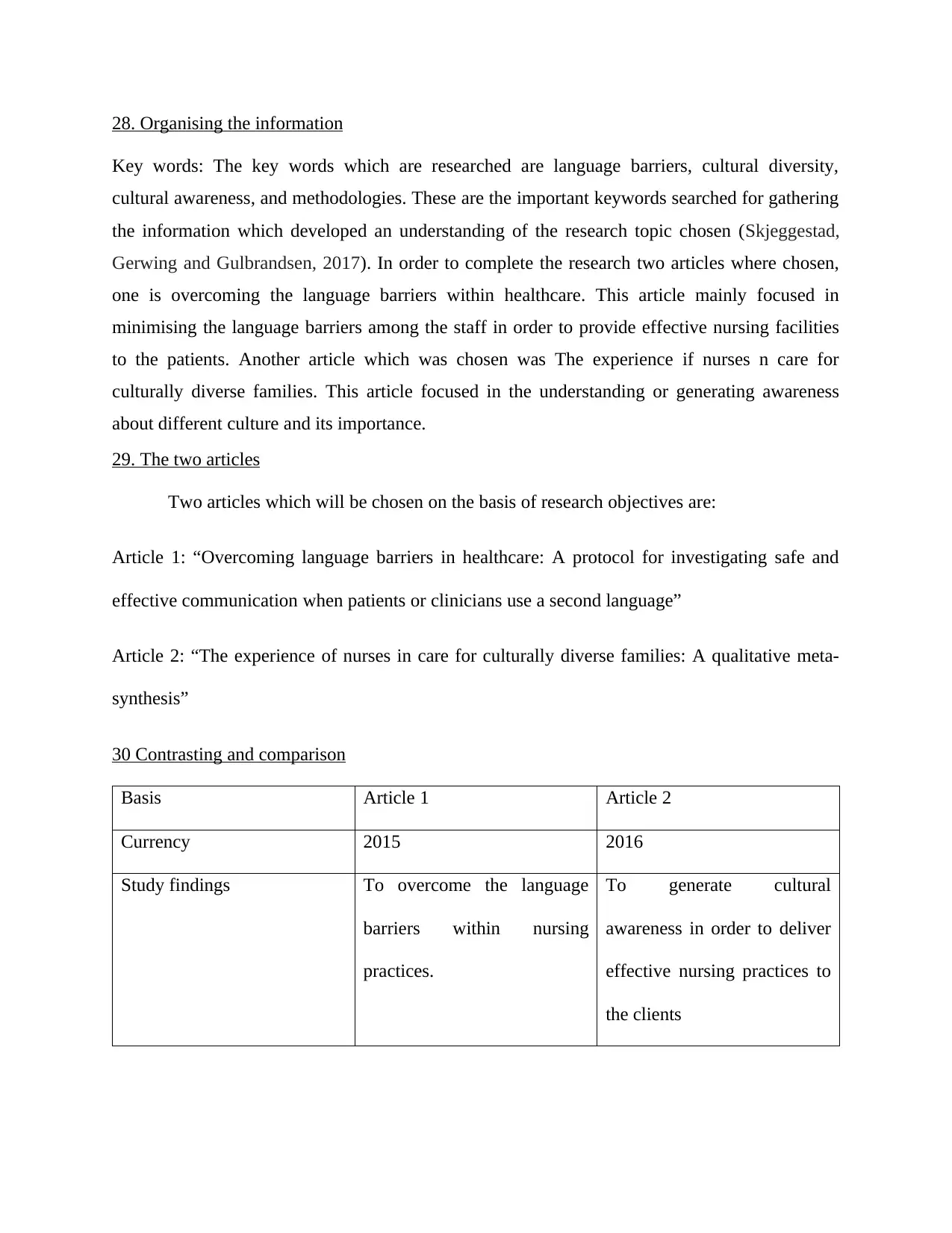
28. Organising the information
Key words: The key words which are researched are language barriers, cultural diversity,
cultural awareness, and methodologies. These are the important keywords searched for gathering
the information which developed an understanding of the research topic chosen (Skjeggestad,
Gerwing and Gulbrandsen, 2017). In order to complete the research two articles where chosen,
one is overcoming the language barriers within healthcare. This article mainly focused in
minimising the language barriers among the staff in order to provide effective nursing facilities
to the patients. Another article which was chosen was The experience if nurses n care for
culturally diverse families. This article focused in the understanding or generating awareness
about different culture and its importance.
29. The two articles
Two articles which will be chosen on the basis of research objectives are:
Article 1: “Overcoming language barriers in healthcare: A protocol for investigating safe and
effective communication when patients or clinicians use a second language”
Article 2: “The experience of nurses in care for culturally diverse families: A qualitative meta-
synthesis”
30 Contrasting and comparison
Basis Article 1 Article 2
Currency 2015 2016
Study findings To overcome the language
barriers within nursing
practices.
To generate cultural
awareness in order to deliver
effective nursing practices to
the clients
Key words: The key words which are researched are language barriers, cultural diversity,
cultural awareness, and methodologies. These are the important keywords searched for gathering
the information which developed an understanding of the research topic chosen (Skjeggestad,
Gerwing and Gulbrandsen, 2017). In order to complete the research two articles where chosen,
one is overcoming the language barriers within healthcare. This article mainly focused in
minimising the language barriers among the staff in order to provide effective nursing facilities
to the patients. Another article which was chosen was The experience if nurses n care for
culturally diverse families. This article focused in the understanding or generating awareness
about different culture and its importance.
29. The two articles
Two articles which will be chosen on the basis of research objectives are:
Article 1: “Overcoming language barriers in healthcare: A protocol for investigating safe and
effective communication when patients or clinicians use a second language”
Article 2: “The experience of nurses in care for culturally diverse families: A qualitative meta-
synthesis”
30 Contrasting and comparison
Basis Article 1 Article 2
Currency 2015 2016
Study findings To overcome the language
barriers within nursing
practices.
To generate cultural
awareness in order to deliver
effective nursing practices to
the clients
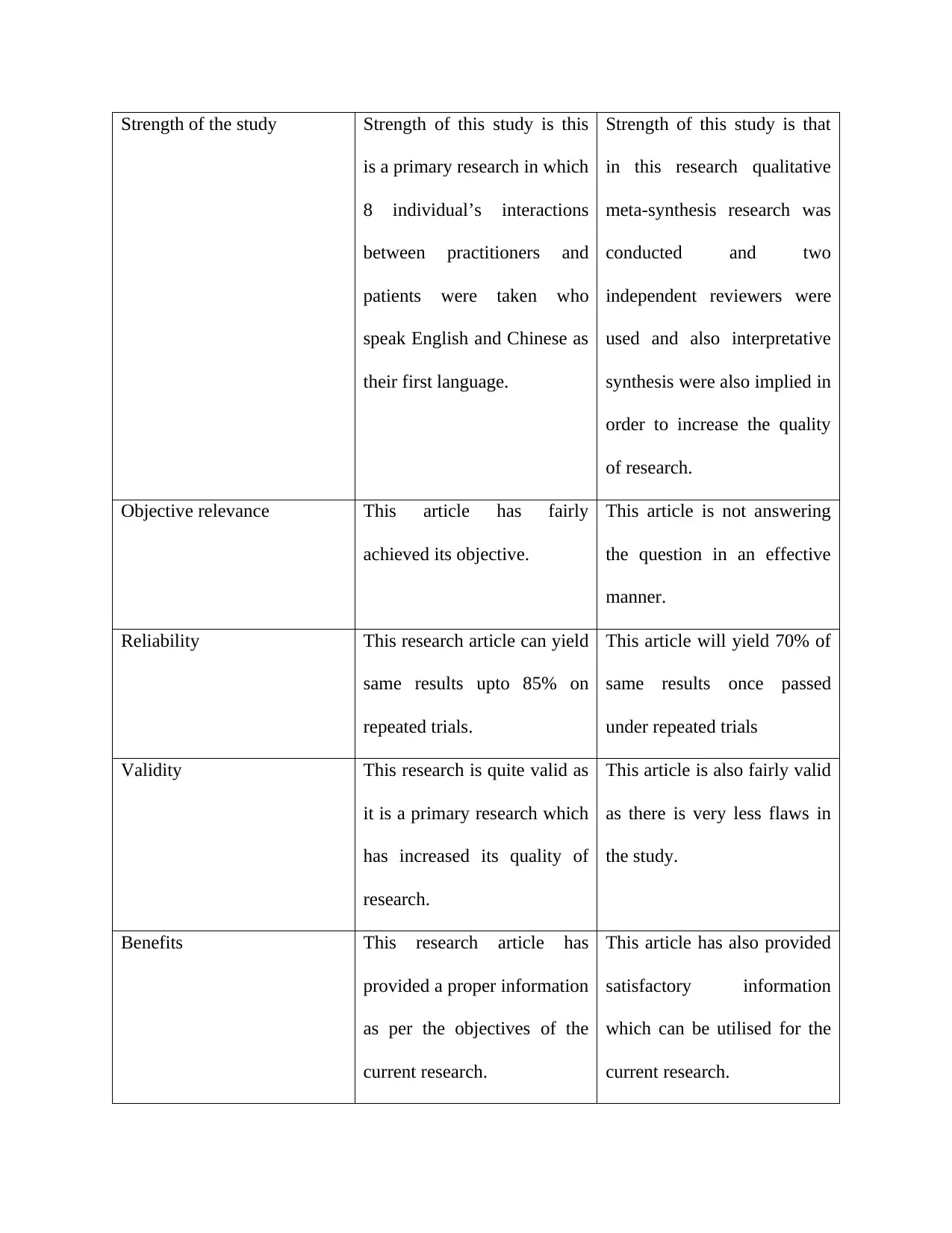
Strength of the study Strength of this study is this
is a primary research in which
8 individual’s interactions
between practitioners and
patients were taken who
speak English and Chinese as
their first language.
Strength of this study is that
in this research qualitative
meta-synthesis research was
conducted and two
independent reviewers were
used and also interpretative
synthesis were also implied in
order to increase the quality
of research.
Objective relevance This article has fairly
achieved its objective.
This article is not answering
the question in an effective
manner.
Reliability This research article can yield
same results upto 85% on
repeated trials.
This article will yield 70% of
same results once passed
under repeated trials
Validity This research is quite valid as
it is a primary research which
has increased its quality of
research.
This article is also fairly valid
as there is very less flaws in
the study.
Benefits This research article has
provided a proper information
as per the objectives of the
current research.
This article has also provided
satisfactory information
which can be utilised for the
current research.
is a primary research in which
8 individual’s interactions
between practitioners and
patients were taken who
speak English and Chinese as
their first language.
Strength of this study is that
in this research qualitative
meta-synthesis research was
conducted and two
independent reviewers were
used and also interpretative
synthesis were also implied in
order to increase the quality
of research.
Objective relevance This article has fairly
achieved its objective.
This article is not answering
the question in an effective
manner.
Reliability This research article can yield
same results upto 85% on
repeated trials.
This article will yield 70% of
same results once passed
under repeated trials
Validity This research is quite valid as
it is a primary research which
has increased its quality of
research.
This article is also fairly valid
as there is very less flaws in
the study.
Benefits This research article has
provided a proper information
as per the objectives of the
current research.
This article has also provided
satisfactory information
which can be utilised for the
current research.
⊘ This is a preview!⊘
Do you want full access?
Subscribe today to unlock all pages.

Trusted by 1+ million students worldwide
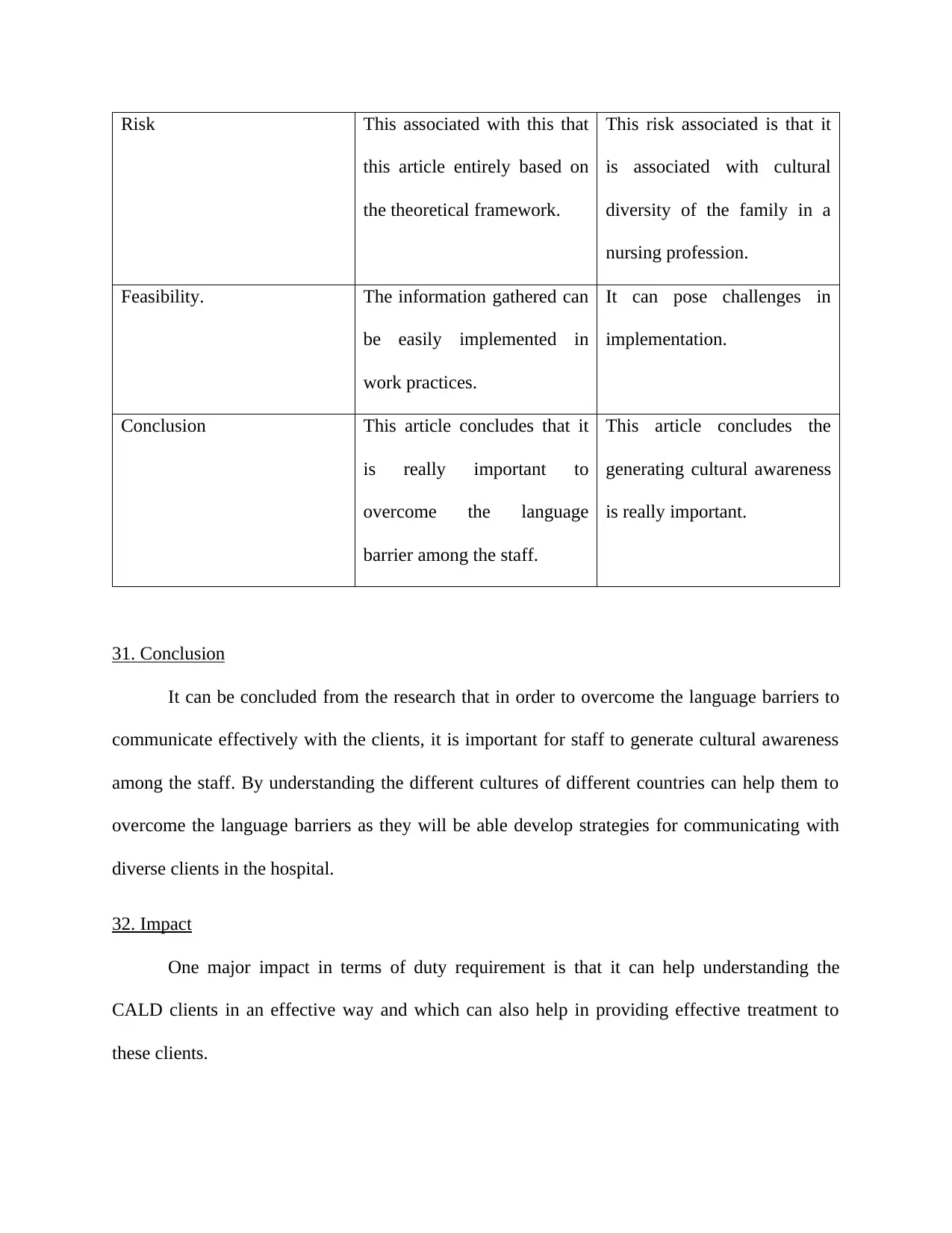
Risk This associated with this that
this article entirely based on
the theoretical framework.
This risk associated is that it
is associated with cultural
diversity of the family in a
nursing profession.
Feasibility. The information gathered can
be easily implemented in
work practices.
It can pose challenges in
implementation.
Conclusion This article concludes that it
is really important to
overcome the language
barrier among the staff.
This article concludes the
generating cultural awareness
is really important.
31. Conclusion
It can be concluded from the research that in order to overcome the language barriers to
communicate effectively with the clients, it is important for staff to generate cultural awareness
among the staff. By understanding the different cultures of different countries can help them to
overcome the language barriers as they will be able develop strategies for communicating with
diverse clients in the hospital.
32. Impact
One major impact in terms of duty requirement is that it can help understanding the
CALD clients in an effective way and which can also help in providing effective treatment to
these clients.
this article entirely based on
the theoretical framework.
This risk associated is that it
is associated with cultural
diversity of the family in a
nursing profession.
Feasibility. The information gathered can
be easily implemented in
work practices.
It can pose challenges in
implementation.
Conclusion This article concludes that it
is really important to
overcome the language
barrier among the staff.
This article concludes the
generating cultural awareness
is really important.
31. Conclusion
It can be concluded from the research that in order to overcome the language barriers to
communicate effectively with the clients, it is important for staff to generate cultural awareness
among the staff. By understanding the different cultures of different countries can help them to
overcome the language barriers as they will be able develop strategies for communicating with
diverse clients in the hospital.
32. Impact
One major impact in terms of duty requirement is that it can help understanding the
CALD clients in an effective way and which can also help in providing effective treatment to
these clients.
Paraphrase This Document
Need a fresh take? Get an instant paraphrase of this document with our AI Paraphraser
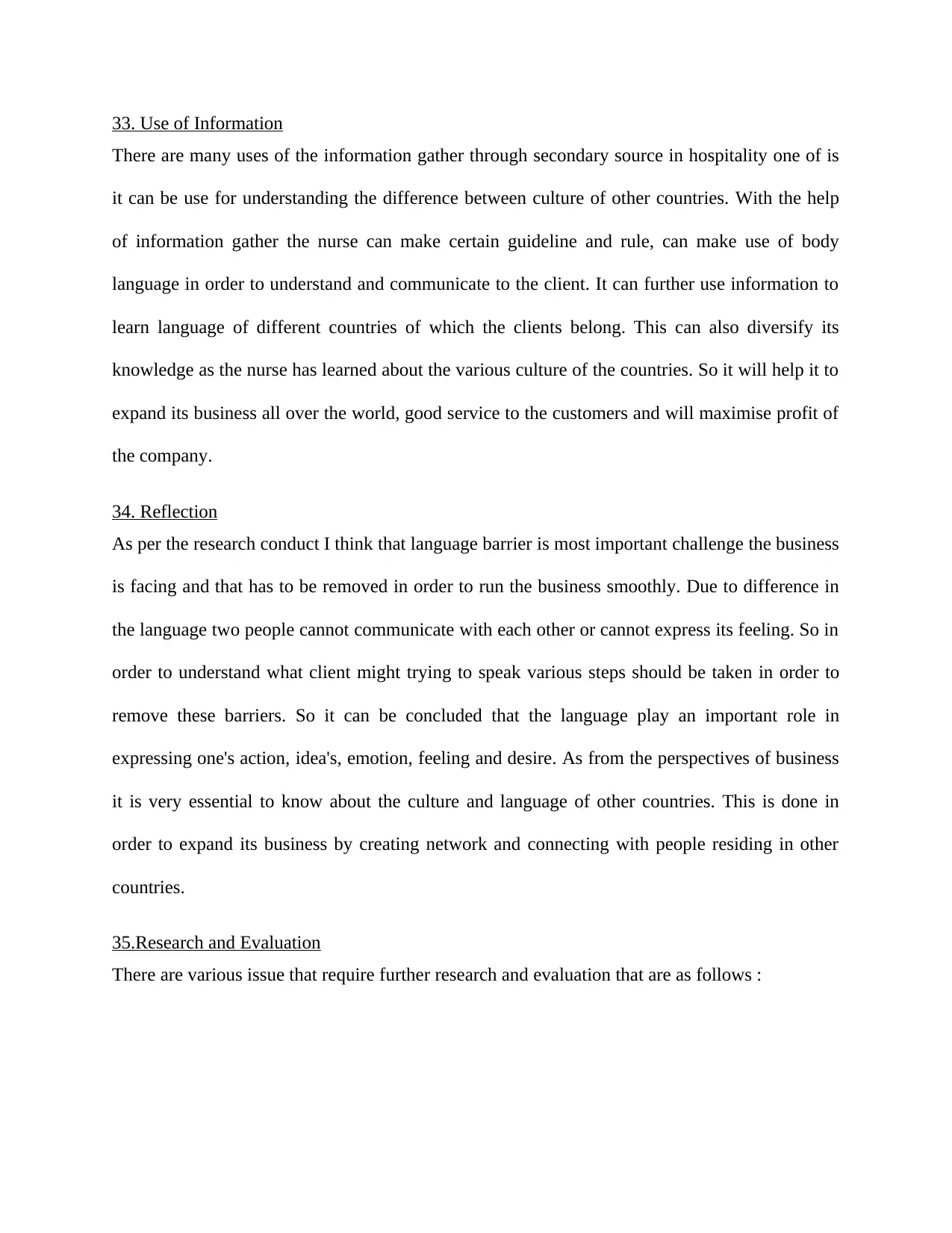
33. Use of Information
There are many uses of the information gather through secondary source in hospitality one of is
it can be use for understanding the difference between culture of other countries. With the help
of information gather the nurse can make certain guideline and rule, can make use of body
language in order to understand and communicate to the client. It can further use information to
learn language of different countries of which the clients belong. This can also diversify its
knowledge as the nurse has learned about the various culture of the countries. So it will help it to
expand its business all over the world, good service to the customers and will maximise profit of
the company.
34. Reflection
As per the research conduct I think that language barrier is most important challenge the business
is facing and that has to be removed in order to run the business smoothly. Due to difference in
the language two people cannot communicate with each other or cannot express its feeling. So in
order to understand what client might trying to speak various steps should be taken in order to
remove these barriers. So it can be concluded that the language play an important role in
expressing one's action, idea's, emotion, feeling and desire. As from the perspectives of business
it is very essential to know about the culture and language of other countries. This is done in
order to expand its business by creating network and connecting with people residing in other
countries.
35.Research and Evaluation
There are various issue that require further research and evaluation that are as follows :
There are many uses of the information gather through secondary source in hospitality one of is
it can be use for understanding the difference between culture of other countries. With the help
of information gather the nurse can make certain guideline and rule, can make use of body
language in order to understand and communicate to the client. It can further use information to
learn language of different countries of which the clients belong. This can also diversify its
knowledge as the nurse has learned about the various culture of the countries. So it will help it to
expand its business all over the world, good service to the customers and will maximise profit of
the company.
34. Reflection
As per the research conduct I think that language barrier is most important challenge the business
is facing and that has to be removed in order to run the business smoothly. Due to difference in
the language two people cannot communicate with each other or cannot express its feeling. So in
order to understand what client might trying to speak various steps should be taken in order to
remove these barriers. So it can be concluded that the language play an important role in
expressing one's action, idea's, emotion, feeling and desire. As from the perspectives of business
it is very essential to know about the culture and language of other countries. This is done in
order to expand its business by creating network and connecting with people residing in other
countries.
35.Research and Evaluation
There are various issue that require further research and evaluation that are as follows :
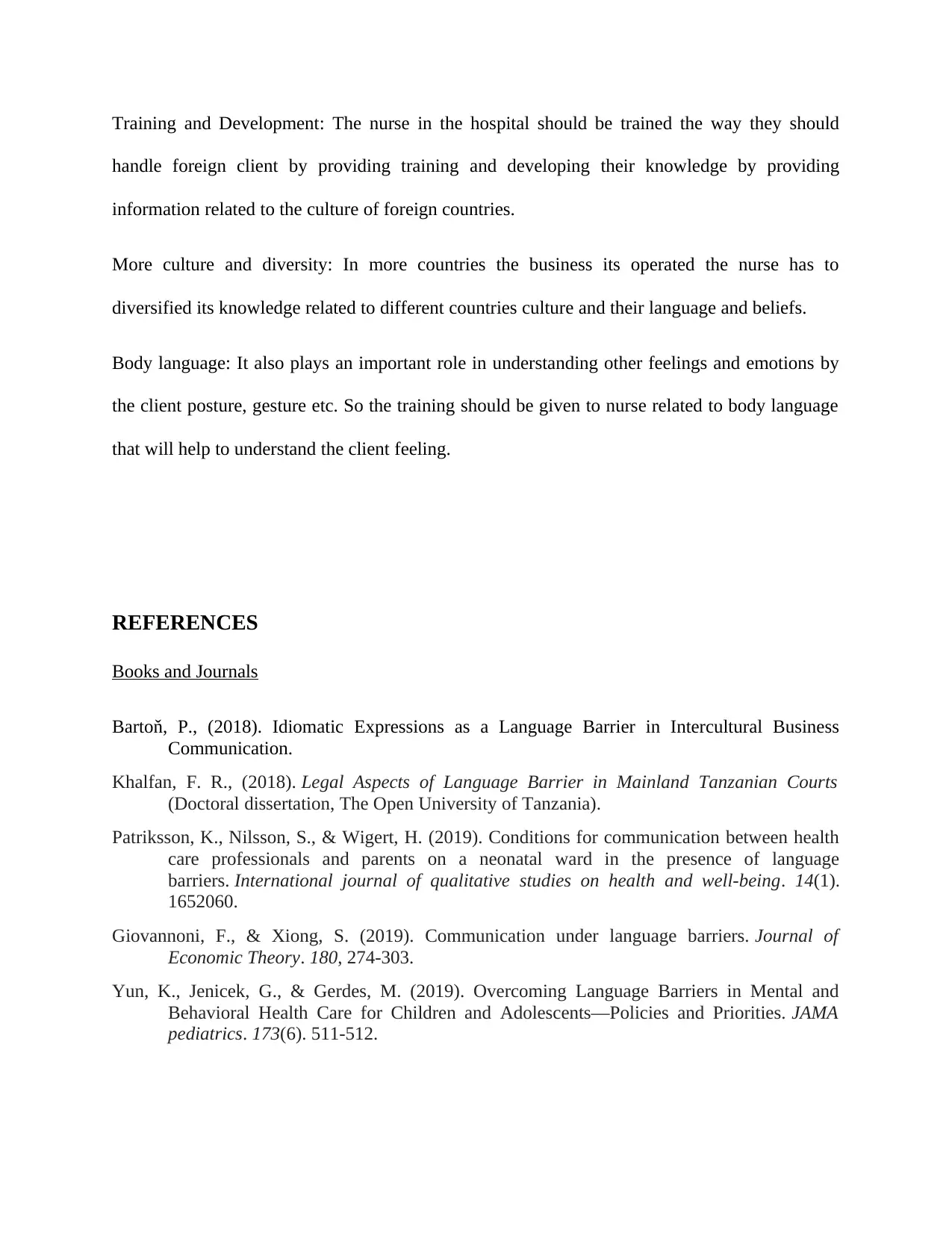
Training and Development: The nurse in the hospital should be trained the way they should
handle foreign client by providing training and developing their knowledge by providing
information related to the culture of foreign countries.
More culture and diversity: In more countries the business its operated the nurse has to
diversified its knowledge related to different countries culture and their language and beliefs.
Body language: It also plays an important role in understanding other feelings and emotions by
the client posture, gesture etc. So the training should be given to nurse related to body language
that will help to understand the client feeling.
REFERENCES
Books and Journals
Bartoň, P., (2018). Idiomatic Expressions as a Language Barrier in Intercultural Business
Communication.
Khalfan, F. R., (2018). Legal Aspects of Language Barrier in Mainland Tanzanian Courts
(Doctoral dissertation, The Open University of Tanzania).
Patriksson, K., Nilsson, S., & Wigert, H. (2019). Conditions for communication between health
care professionals and parents on a neonatal ward in the presence of language
barriers. International journal of qualitative studies on health and well-being. 14(1).
1652060.
Giovannoni, F., & Xiong, S. (2019). Communication under language barriers. Journal of
Economic Theory. 180, 274-303.
Yun, K., Jenicek, G., & Gerdes, M. (2019). Overcoming Language Barriers in Mental and
Behavioral Health Care for Children and Adolescents—Policies and Priorities. JAMA
pediatrics. 173(6). 511-512.
handle foreign client by providing training and developing their knowledge by providing
information related to the culture of foreign countries.
More culture and diversity: In more countries the business its operated the nurse has to
diversified its knowledge related to different countries culture and their language and beliefs.
Body language: It also plays an important role in understanding other feelings and emotions by
the client posture, gesture etc. So the training should be given to nurse related to body language
that will help to understand the client feeling.
REFERENCES
Books and Journals
Bartoň, P., (2018). Idiomatic Expressions as a Language Barrier in Intercultural Business
Communication.
Khalfan, F. R., (2018). Legal Aspects of Language Barrier in Mainland Tanzanian Courts
(Doctoral dissertation, The Open University of Tanzania).
Patriksson, K., Nilsson, S., & Wigert, H. (2019). Conditions for communication between health
care professionals and parents on a neonatal ward in the presence of language
barriers. International journal of qualitative studies on health and well-being. 14(1).
1652060.
Giovannoni, F., & Xiong, S. (2019). Communication under language barriers. Journal of
Economic Theory. 180, 274-303.
Yun, K., Jenicek, G., & Gerdes, M. (2019). Overcoming Language Barriers in Mental and
Behavioral Health Care for Children and Adolescents—Policies and Priorities. JAMA
pediatrics. 173(6). 511-512.
⊘ This is a preview!⊘
Do you want full access?
Subscribe today to unlock all pages.

Trusted by 1+ million students worldwide
1 out of 13
Related Documents
Your All-in-One AI-Powered Toolkit for Academic Success.
+13062052269
info@desklib.com
Available 24*7 on WhatsApp / Email
![[object Object]](/_next/static/media/star-bottom.7253800d.svg)
Unlock your academic potential
Copyright © 2020–2025 A2Z Services. All Rights Reserved. Developed and managed by ZUCOL.





